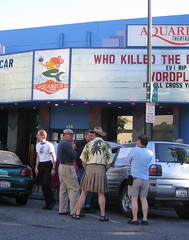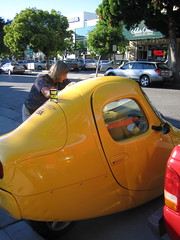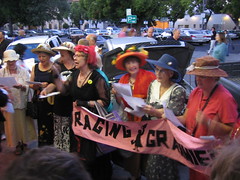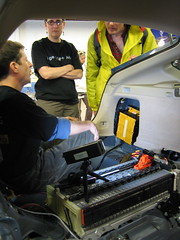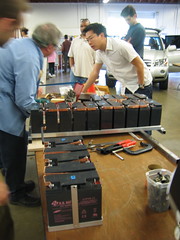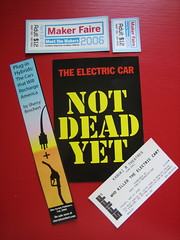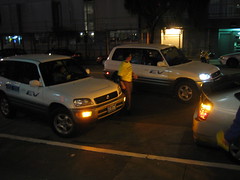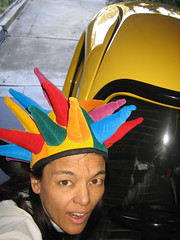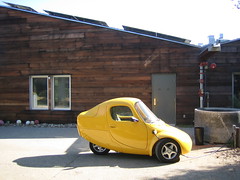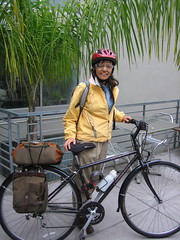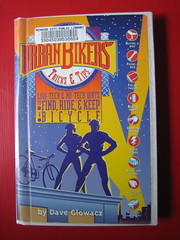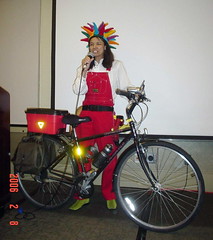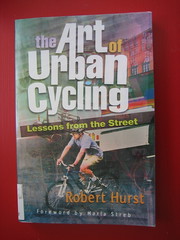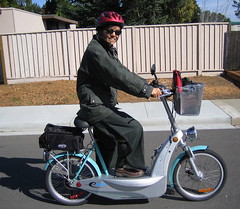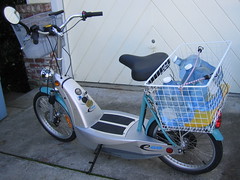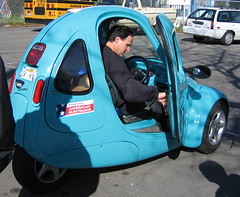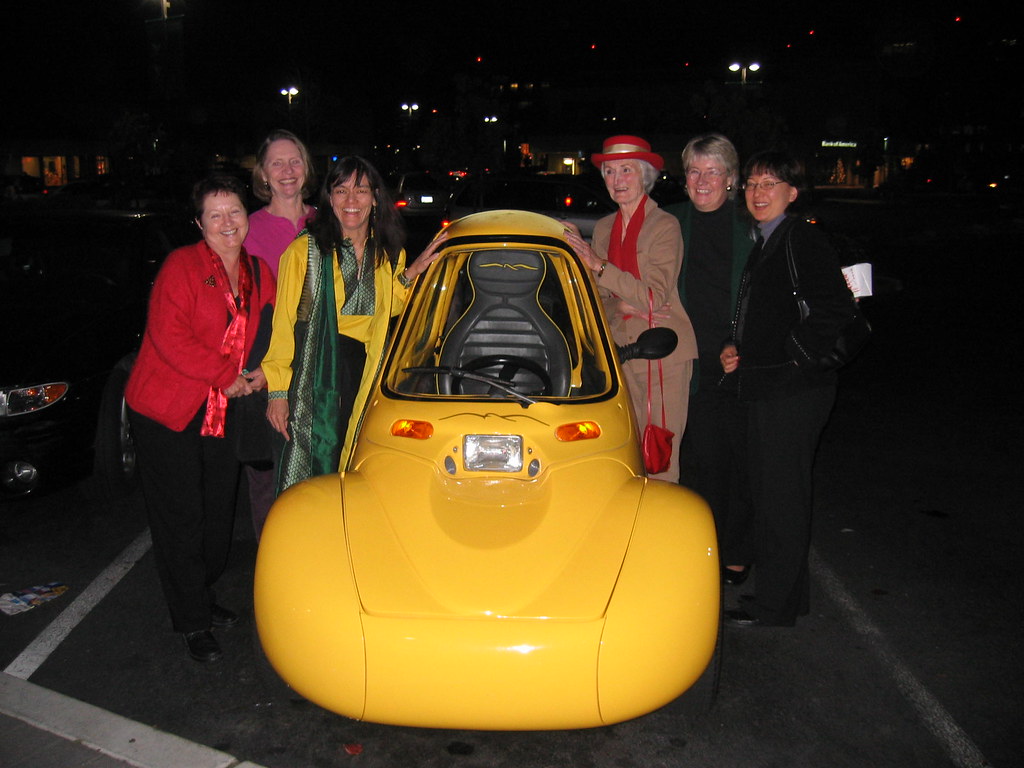Who Killed The Electric Car Opening
The opening weekend of Who Killed the Electric Car was our opportunity to send EV owners to theatres all over the Bay Area to show off the cars and ask people to join us in the campaign to plug in America. I used to work at the Aquarius Theatre and my friend Tim works there now, so he directed me to the right person to help us spread the word about our EV rally. It was quite an event. We had four or five RAV 4 EVs the first night. There are more of them than any other EV, so when they show up I always feel like the reinformcement troops have arrived. Kind of like Stormtroopers if they were the good guys. The EV 1, the star of the movie, is definately our Princess Lea. Here you can see Brandy in his utilikilt, which I covet. It's part of his EV demo outfit. People remember him because of it. He wore the black one on Friday. Three of us showing our EVs here all have solar panels on our homes, so we were able to promote totally clean cars. Many EV owners do invest in solar because the savings in gas money pays for the system much sooner. Brandy said he paid for his in two and a half years.
The timing of this movie coming on the heels of An Inconvenient Truth, couldn't have been better. It's not a great movie, as Tim critically pointed out, really more of a home movie given the inexperience of the filmaker, himself a former EV1 driver, but it does tell all the details of the plot to roll back California's zero emissions mandate and get rid of production electric cars. So in that sense it is a good documentary and it gets people riled up.
I had a jolly time hanging out in the street showing off the Sparrow. Friends showed up to play. We put our "Not Dead Yet" postcards on each car. I ran into more friends coming to see Wordplay. This must be the year of the documentary.
The Raging Grannies sent word out that they would be attending the movie on Saturday, so I asked them if they could sing something and they were only too happy to oblige. They even wrote a song especially for us to the tune of Where oh Where Has My Little Dog Gone. Their other songs were about gas guzzlers sending us to war for oil. They had written these for the Jumpstart Ford campaign when we picketed local Ford dealerships.
The following weekend of Who Killed The Electric Car they decided to go to Santana Row theatres. When I told Granny Ruth that EV owners had been asked to leave the premises because they were handing out literature about the electric car, she organized a rally to protest the censorship. And dang if they didn't get themselves on the 10 o'clock news. It was sweet. The theatre didn't know what hit them and decided not to have the Grannies arrested. Technically they could have, since it was private property the Grannies were occupying. Santana Row is a mall that's made to look like a street with sidewalks, but it is not public property as legitimate streets and sidewalks are where citizens are allowed freedom of speech. Faux street, faux sidewalk, faux rights, I say.
The point the news story was making was that it was private property which was being violated by the Grannies. At the same time it was terrific coverage for the Grannies to tell the whole story and show our brochures about the electric cars. "Electric cars are available, plug-in hybrids exist," said Granny Ruth, as if the mall was trying to suppress the information. I did notice that they were not showing the movie soon after that.
The timing of this movie coming on the heels of An Inconvenient Truth, couldn't have been better. It's not a great movie, as Tim critically pointed out, really more of a home movie given the inexperience of the filmaker, himself a former EV1 driver, but it does tell all the details of the plot to roll back California's zero emissions mandate and get rid of production electric cars. So in that sense it is a good documentary and it gets people riled up.
I had a jolly time hanging out in the street showing off the Sparrow. Friends showed up to play. We put our "Not Dead Yet" postcards on each car. I ran into more friends coming to see Wordplay. This must be the year of the documentary.
The Raging Grannies sent word out that they would be attending the movie on Saturday, so I asked them if they could sing something and they were only too happy to oblige. They even wrote a song especially for us to the tune of Where oh Where Has My Little Dog Gone. Their other songs were about gas guzzlers sending us to war for oil. They had written these for the Jumpstart Ford campaign when we picketed local Ford dealerships.
The following weekend of Who Killed The Electric Car they decided to go to Santana Row theatres. When I told Granny Ruth that EV owners had been asked to leave the premises because they were handing out literature about the electric car, she organized a rally to protest the censorship. And dang if they didn't get themselves on the 10 o'clock news. It was sweet. The theatre didn't know what hit them and decided not to have the Grannies arrested. Technically they could have, since it was private property the Grannies were occupying. Santana Row is a mall that's made to look like a street with sidewalks, but it is not public property as legitimate streets and sidewalks are where citizens are allowed freedom of speech. Faux street, faux sidewalk, faux rights, I say.
The point the news story was making was that it was private property which was being violated by the Grannies. At the same time it was terrific coverage for the Grannies to tell the whole story and show our brochures about the electric cars. "Electric cars are available, plug-in hybrids exist," said Granny Ruth, as if the mall was trying to suppress the information. I did notice that they were not showing the movie soon after that.
